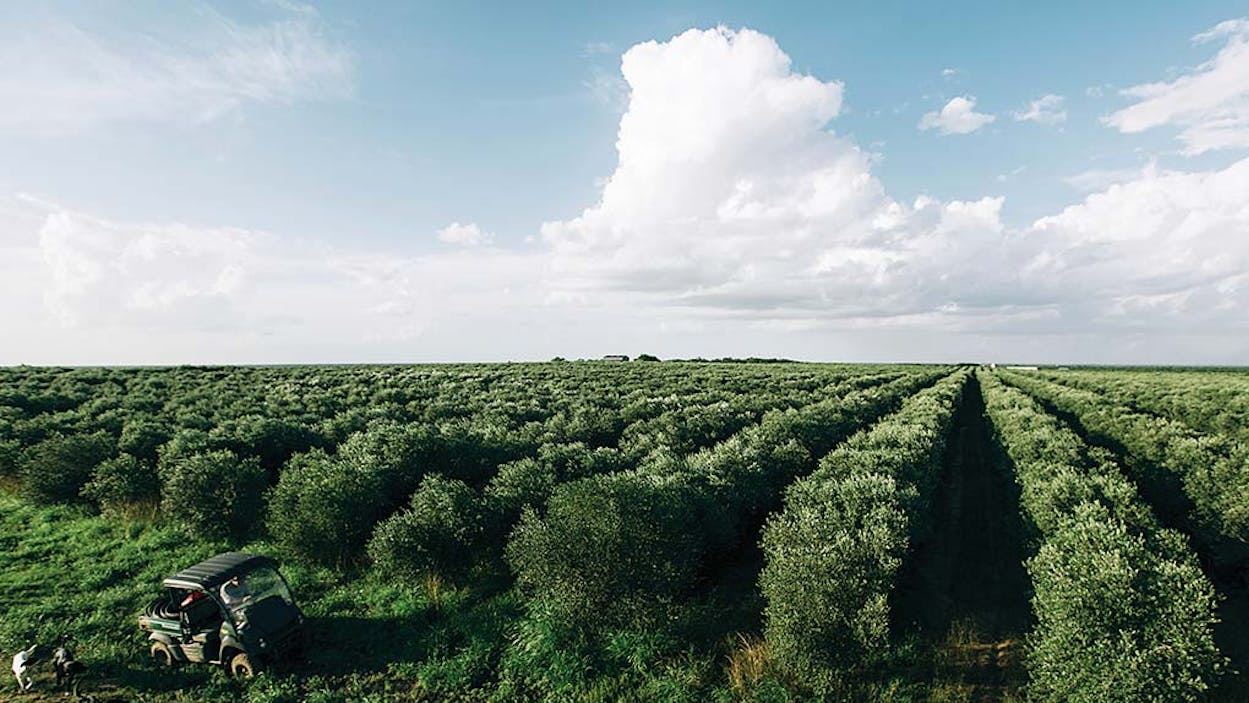Carrizo Springs is a South Texas town full of people trying to pull oil out of the ground. Jim Henry isn’t one of them. He’s trying to pull oil out of trees. On a 67-acre ranch, three miles from the town center, the 68-year-old Dallas businessman cultivates an olive orchard with 40,000 trees. Many of them are regal, well-established specimens, the oldest planted seventeen years ago.
The mature trees in Henry’s orchard are about eight feet high, with sturdy, gray trunks and bushy, unruly tops flush with slim, oblong leaves that curl up when the Texas heat gets serious. Grouped together by the thousands, they resemble a sage-green blanket draped over a rolling landscape. When working the orchard, Henry is humbled by the undertaking. “You realize how little control you have over it, how a greater spirit is at work, but also how it’s great to be along for the ride,” he says. In mid-May, as the trees were on the verge of bearing a speckled array of black, green, and red fruit, Henry’s son Matt drove between them on a four-wheeler, checking irrigation lines with Tolula, a loyal black lab who barks when she discovers a leak.
Nobody plants 40,000 trees as a hobby, and the members of the Henry family, who, along with another family, the Farrells, run the Texas Olive Ranch, are no hobbyists. Texans have been cultivating olives since the thirties, but this operation is the most ambitious attempt yet to turn them into a commercial crop here. Assessing the potential of Texas olive oil, Matt hopped off his vehicle, pointed to the orchard at his back, and said, “The sky’s the limit.”
On paper, he’s right. According to Kimberly Houlding, the president and CEO of the American Olive Oil Producers Association, the United States consumes 10 percent of the world’s olive oil but produces only .5 percent of it. The vast majority of the olive oil we use comes from countries such as Spain, Tunisia, Italy, and France, places where olives have been cultivated for almost six thousand years. Europeans consume so much olive oil they’re jokingly said to bathe in the stuff. Americans aren’t quite there yet, but with rates of consumption having tripled since 1992, we’re definitely starting to wade in.
The gap between what we consume and what we produce, repeated like a mantra by Texas growers, suggests that the state’s olive oil industry is in a situation much like that of the California wine industry in the early seventies. At the time, the U.S. produced a tiny fraction of the world’s vino. Today, led by California, we’re the world’s fourth leading wine producer. Houlding believes that our country’s olive farmers are poised to make a similarly dramatic leap. Right now, there are 42,000 acres of olive trees planted in seven states across the country; Houlding thinks this will soon change. “Our domestic olive oil producers are positioned to provide the high-quality oil that consumers desire,” she says. “We’ll need to expand acreage for oil production to almost 400,000 acres to meet even current demand.”
Texas would be a big part of that leap. The state currently accounts for a mere 9 percent of all acreage dedicated to olives in the U.S.; California, at 83 percent, is the dominant player. But in the years to come, Texas could grab a much bigger share. “We’re at the right place at the right time,” Jim Henry says, noting that Texas enjoys the advantages of cheap land, light agricultural regulation, excellent growing conditions in much of the state, and, in comparison with California, which is suffering an extreme drought, easier access to water.
And there’s a window of opportunity. At the same time that U.S. consumption of olive oil is on the rise, European olive oil has been plagued by adulteration scandals, most of them caused by producers cutting extra-virgin olive oil with cheaper oils, such as soy and sunflower. “The stuff imported from Europe, especially that made from olives from multiple countries, hasn’t held up well,” says Sally Greenberg, the executive director of the National Consumers League. “Your chances of getting the real thing from Europe are at best fifty-fifty.” Texas olive oil, by contrast, is of the highest quality: it’s not only olive oil through and through, it regularly registers acid levels—a key indicator of quality—that are considerably lower than the European standard for extra-virgin olive oil. European production has also been hurt by the outbreak of a deadly disease in Italian orchards.
As with any young industry facing an opportunity, though, the challenges are acute. Olive trees can grow on pretty much any type of terrain; it’s the climate that’s tricky. Growers learned last year that a hard late-spring freeze will destroy young olive flowers; the 2014 harvest in Texas was virtually nonexistent. At the other end of the thermostat, excessive heat, which Texas has plenty of, reduces photosynthesis, causing flower defoliation and devastating yields. Threading this environmental needle is more art than science, so it’s no wonder that, as Texas growers try to figure out where the olive will thrive, orchards have sprung up across much of the state (though not in North and West Texas). Henry believes that Texas’s olive belt should stretch south from Interstate 10 to the Gulf and the border, spreading as far west as Carrizo Springs and as far east as Victoria. No matter where a planter sets his orchard, though, the threat of excessive rain will always create anxiety. Matt Henry is happy about this past May’s record-setting precipitation—“We’ll take it,” he says—but he nervously surveys his orchard for leaves that have turned from dark- to pale-green, a sure indication of a moisture-induced fungal outbreak. Luckily, it doesn’t appear to be a problem.
“We’re still experimenting here in Texas,” says 75-year-old Sandy Winokur, who owns and operates Sandy Oaks Olive Orchard, in Elmendorf, just south of San Antonio. Winokur grows 11,000 trees on forty acres and is about to double that acreage. Her enterprise is a promising example of what nearly two decades of trial-and-error research can yield. She planted her first trees in 1998, when she had no idea what would grow there. Her biggest challenge has been her property’s extremely sandy soil. “I describe it as ‘beachfront property without the ocean,’ ” she says. The nature of the terrain means that she can’t use mechanical harvesters; they’d tear the trees right out of the ground. And because of the ground’s lack of nutrients, she has to engage in “fertigating,” injecting organic fertilizers into her irrigation system.
To avoid monoculture, Winokur has planted a patchwork of 32 olive varieties across her acreage and 6 more in her nursery. Yet most of her trees—as is the case with all Texas growers—are arbequina, a hardy Spanish tree that can withstand extreme shifts in climate. With the help of some Texas A&M scientists, she even discovered a symbiotic relationship between olive and oak trees after noticing that a clump of arbequinas around a live oak grew more vigorously than other olive trees.
Winokur is as entrepreneurially savvy as she is botanically curious. Abutting her orchard is a nursery of 10,000 olive seedlings, which she sells to start-up orchards throughout the state. Her on-site gift shop—which teems with tourists every Saturday—sells everything from olive oil to cured table olives to olive oil–based soap to dried olive leaves for tea. (She also sells bags of Move ’Em Out, an organic spray for combatting leaf-cutter ants that she invented.) Behind the shop stands the orchard’s crown jewel: a pristine olive mill imported from Italy, which Winokur uses to extract oil from her olives and those purchased from other growers.
The Old World shapes Winokur’s operation in other ways as well. “Over the decades I have traveled to the Middle East, Europe, and Australia, and I always noticed olive groves and, you know, it reminded me of Texas.” When she decided to buy land near San Antonio, where she was born, she was hooked the moment she saw the Elmendorf property. “I immediately loved it because of the beauty of the century-old oak trees. I also liked the fact that the land was unimproved and well-drained and that I could put my own touch on it. Nobody had screwed it up.” The entire operation now churns out enough olive oil for her to sell online, in boutique shops, and at San Antonio’s Pearl Farmers Market.
There are plenty of other growers around the state—Bella Vista Ranch, in Wimberley; Lone Star Olive Ranch, in Madisonville; Central Texas Olive Ranch, in Granger. And foodies who frequent farmers’ markets in Texas have grown accustomed to seeing their wares at the stands on Saturday mornings. The Henrys and Farrells have aimed higher, selling their products at dozens of H-E-Bs throughout Texas and 18 of the state’s 27 Whole Foods Markets. “They just love the stuff,” Matt’s brother Josh, who oversees the orchard’s distribution, says of both retail chains. “They tell us that as long as we make it, they’ll take it.” Still, virtually every drop of olive oil produced in Texas has, at this point, stayed in Texas.
That could soon change, and in a surprising way. Jim Henry may have long entertained ambitions of competing with the Mediterranean farmers who invented the olive oil industry, but he now finds himself in the position of collaborating with them. Last year a group of Spanish investors, hoping to combine foreign cash with local expertise, consulted with Henry about investment opportunities. A group of Syrian investors has also approached him, seeking help in planting an expansive orchard in Livingston. And last summer he formed a partnership with Turkish investors who have planted 70,000 trees in a Victoria orchard and may end up blending Texas-grown oil with oil from elsewhere. Though the big European growers have been doing that sort of thing in California for years, this would be a major shift for Texas growers, who have prided themselves on their oil’s regional identity.
“The olive oil industry is at its core an international business,” Henry says. “It’s hard to be commercially successful without international participation. I think it’s just a matter of time before the large internationals come to Texas.” How this will ultimately play out is, for now, a series of open questions. Will Texas growers maintain their distinctive regional identity as the rest of the world moves in? Will they get swallowed up by Big Olive Oil? Or will a future drought starve the industry before it has a chance to flourish? Henry, like all of his peers, is bullish. “This could be a great story,” he says.
- More About:
- Business







